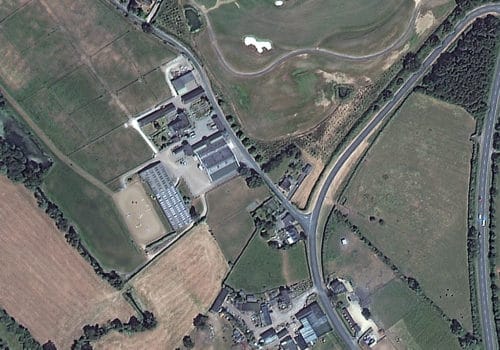
How to Buy Satellite Imagery
Satellite imagery has become one of the most powerful tools for understanding our world, capturing every detail of Earth from
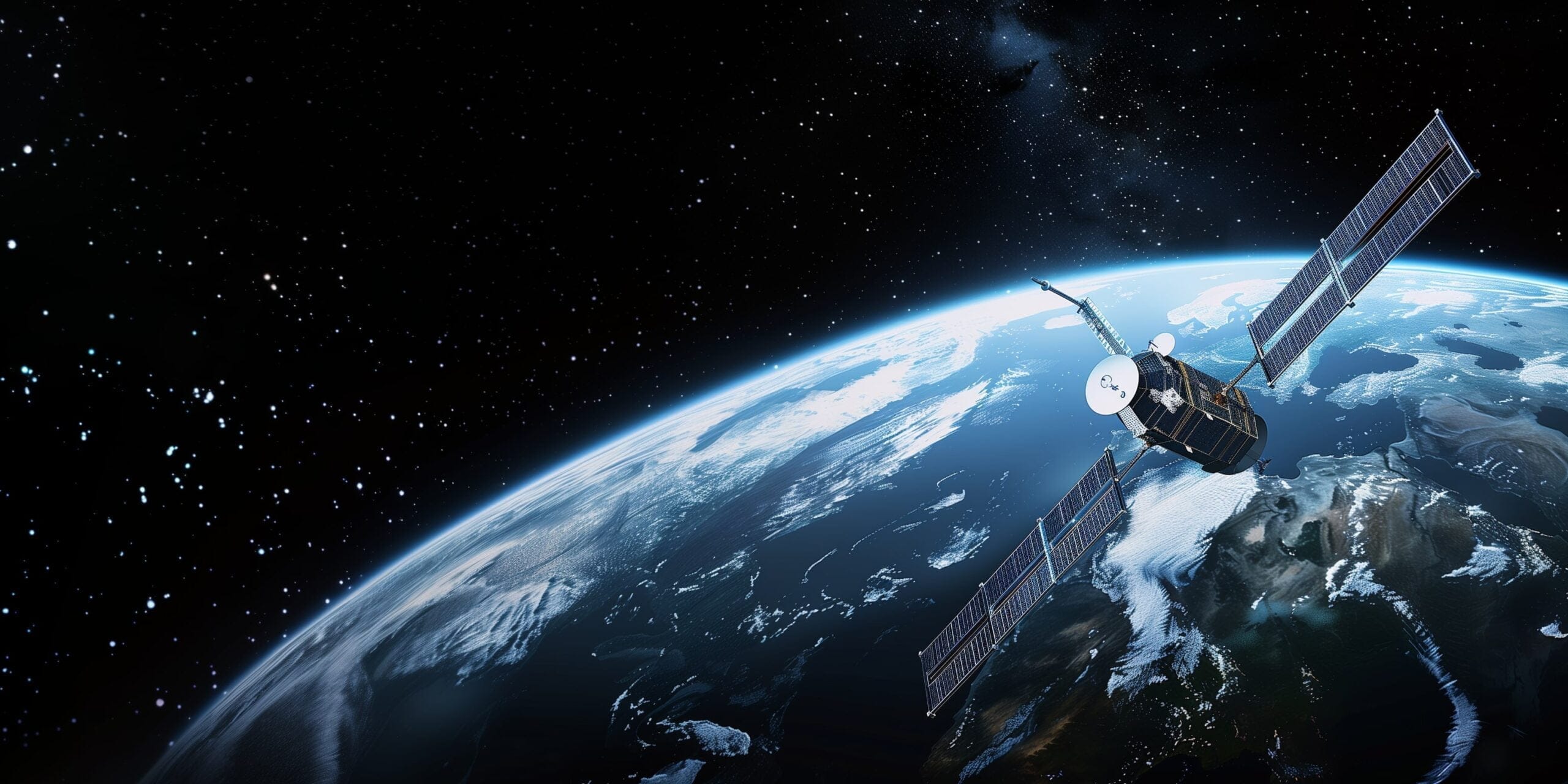
When it comes to “High-Resolution FREE Updated satellite imagery 2025″, the options are endless, depending on what you’re looking for. Some platforms let you easily view the data directly in your browser, while others allow you to download and analyze it for deeper insights. Some are dedicated to high-resolution free high-resolution satellite maps & imagery 2025, while others offer high-resolution satellite images for purchase.
Now, you might be wondering which platforms provide the best updated high resolution free satellite images in 2025? Or where you can find updated high-resolution satellite maps free of charge?
If you’re after the most up-to-date images or the highest quality available, don’t worry—we’ve got you covered.
In this article, we’ll walk you through the 22 best sources of latest free satellite maps and Imagery, and highlight what makes each platform unique.
But first, let me clear something up. If you’ve been dreaming of accessing live satellite feeds of your house, well, we need to manage those expectations.
Unfortunately, real-time satellite imagery isn’t quite as available as Hollywood would like us to think.
The truth is, the updated high resolution free satellite imagery & satellite maps in 2025 available today is often either a bit outdated (ranging from a few months to a few years) or lower in resolution.
This means you might be able to see basic structures, like buildings, but not the fine details—such as cars or people—especially if you’re relying on satellite maps high resolution free options.
Now, if you’re wondering about the difference between high and low-resolution imagery, For instance:
Think of it like comparing a crisp photo on your smartphone (high resolution) to a blurry image from a very old camera (low resolution). The contrast is huge, and it’s important to know what kind of data you need before diving in.
Let me paint a picture for you: imagine seeing the difference between two satellite views. One shows sharp details where you can identify cars, buildings, and even smaller objects.
The other? It’s a blur, giving you a general idea of land use but not much else. The former represents commercial high-resolution data, often sold by private companies, while the latter is typical of free, open-access platforms.
Here’s the exciting part: despite the limitations, we live in a fantastic time where high-resolution satellite images free and free updated satellite maps 2025 options are available to anyone curious enough to explore.
The internet is filled with platforms offering access to Earth observation data, but with so many options, it can be tough to find the one that meets your needs.
Whether you’re looking for high resolution satellite images for scientific research, real-time streaming, or just a way to explore historical satellite imagery, we’ve compiled a list of the best sources to help you navigate the vast ocean of available data.
And the best part? All of this high-resolution satellite imagery is available for free. You just need to know where to look.
Visit here to get best high-resolution satellite imagery for all industries from XRTech Group
Visit – How Up to Date is Google Earth? Complete Guide
Visit – See Live Satellite View of Your House in Real-Time
Keep reading as we dive into the top 22 latest sources for free satellite imagery & maps, and let us guide you to the perfect match for your needs.
*Note: This is archived imagery. Click the button above to request new satellite imagery with recent updates.
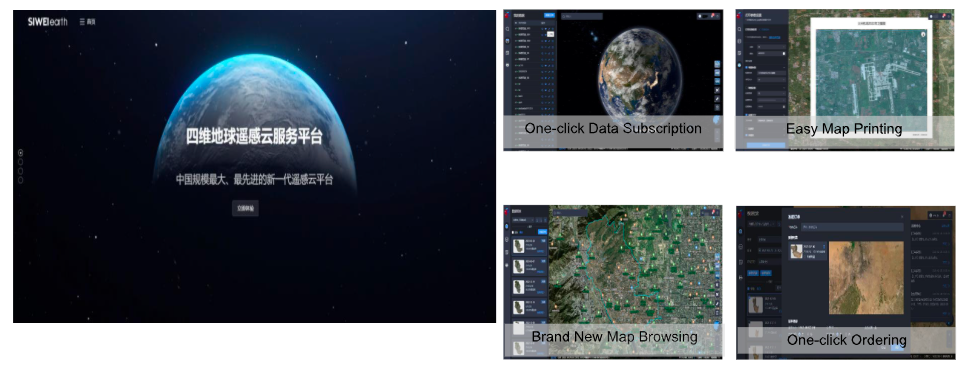
At XRTech Group, we are committed to delivering free updated high-resolution satellite imagery and updated satellite maps in 2025 to help businesses, researchers, and individuals explore the world from a new perspective. Whether you’re involved in urban planning, environmental monitoring, disaster response, agriculture, or academic research, our high-resolution satellite images provide unmatched clarity and reliability.
With an extensive satellite constellation, an easy-to-use platform, and a wealth of archived and real-time imagery, XRTech Group is the leading choice for those seeking high-quality satellite maps in 2025. Our platform ensures seamless access to satellite data through real-time satellite awareness, on-demand imagery requests, and a robust archive dating back to 1999.
At XRTech Group, we provide access to over 60 high-performance satellites that capture detailed and precise imagery of our planet. Our vast constellation includes some of the most advanced satellites in the industry, each specializing in different imaging capabilities:
These satellites cover a wide range of imaging needs, from panchromatic, multispectral, and hyperspectral optical imagery to radar-based SAR imagery for all-weather, day-and-night monitoring. Whether you need historical data for analysis or want to capture new high-resolution images on demand, our satellite network delivers the best 2025 satellite maps and latest Earth observation data for various applications.
We have streamlined the process of accessing our free updated high-resolution satellite imagery and updated satellite maps in 2025 to ensure you get the data you need quickly and efficiently. Simply follow these steps:
Our user-friendly platform ensures a smooth and hassle-free experience, allowing you to access the best 2025 satellite maps with ease.
Sign up now and gain free access to the most advanced satellite imagery and maps of 2025. Let XRTech Group be your trusted partner in Earth observation and geospatial intelligence.
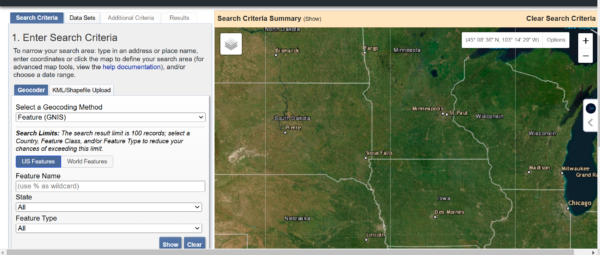
When it comes to free satellite imagery & updated satellite maps 2025, one of the most comprehensive and authoritative platforms available is the USGS EarthExplorer. Managed by the United States Geological Survey (USGS), EarthExplorer offers a treasure trove of high-resolution satellite images, aerial photos, and UAV (drone) data. It’s your go-to source for decades’ worth of Earth imagery, ranging from optical to radar data, and it’s all free to access, making it an invaluable resource for a wide variety of uses.
At the heart of EarthExplorer’s offering is its collection of over 40 years of satellite images free from the USGS and NASA’s Landsat missions. Landsat has been continuously capturing detailed images of the Earth’s surface, providing a rich archive that dates all the way back to the 1970s. As of today, Landsat 8 provides some of the most recent high-resolution satellite images for optical data, available to everyone for no cost.
But that’s not all! EarthExplorer also offers data from a variety of other sources. This includes MODIS satellite data (from the NASA Terra and Aqua missions), ASTER (Advanced Spaceborne Thermal Emission and Reflection Radiometer), and even Sentinel-2 data from the European Space Agency. And if you’re interested in historical imagery, EarthExplorer also offers Spy Satellite imagery (like CORONA), which has been declassified and is available for public use.
EarthExplorer allows users to filter their searches by area, date, and even cloud cover, making it easier to find the updated satellite maps 2025 high resolution free that meets your needs. You can search by entering coordinates, uploading a file, or drawing directly on the map. For advanced users, EarthExplorer also includes a “feature-based search,” which lets you locate specific features, like ancient roads or archaeological sites, from satellite images worldwide.
Once you’ve found the free satellite imagery you need, EarthExplorer lets you download the data in various formats. Depending on your project, you can select different satellite satellite maps and images resolutions, including natural color and thermal imagery. If you’re downloading large datasets, you’ll need the Bulk Download Application, which simplifies the process.
While EarthExplorer’s platform is fantastic for finding and downloading free satellite imagery, it doesn’t offer built-in tools for analyzing this data. You’ll need specialized software, like GIS (Geographic Information System) tools, to process and interpret the images you download. For researchers and scientists, EarthExplorer is a goldmine, but it may take some time to familiarize yourself with the interface and data formats, especially if you’re new to working with geospatial data.
The biggest advantage of using EarthExplorer is the sheer volume and quality of data available. Whether you need the latest high-resolution satellite images or historical data stretching back several decades, EarthExplorer has you covered. It’s ideal for researchers, scientists, and anyone with a strong interest in Earth observation data.
The free access to Landsat imagery and other high-quality datasets makes it a standout choice for anyone who needs accurate and detailed satellite images free of charge. You’ll also find hyperspectral data from Hyperion, which offers even more spectral detail for advanced analysis.
EarthExplorer is perfect for anyone who needs access to free satellite imagery for research, environmental studies, or other scientific applications. If you’re someone who enjoys exploring historical satellite data or working with advanced remote sensing products, this platform is ideal for you. But, be prepared for a learning curve when it comes to navigating the platform.

If you’re looking for free satellite imagery, the Copernicus Data Space Ecosystem is an excellent place to start. Launched in January 2023, this new platform replaces the Copernicus Open Access Hub, offering access to Sentinel satellite imagery and a variety of Earth observation data. It’s a perfect tool for those interested in real-time data and visualizations for environmental monitoring, disaster management, and land use analysis. And best of all, it’s completely free.
The Copernicus Data Space Ecosystem delivers the latest satellite data from all active Sentinel missions, making it a key player in providing free satellite imagery. Here’s a breakdown of what’s available:
These datasets are crucial for tracking changes on Earth, from land degradation to deforestation and urban expansion.
Navigating the Copernicus Data Space Ecosystem has become simpler with the Copernicus Browser, which is designed to help users—whether beginners or experts—easily access free satellite maps. The interface allows you to:
Once you’ve located the imagery you need, you can download the satellite data in various formats, including visualizations or user-created layers. This provides a lot of flexibility depending on the type of project you’re working on.
The Copernicus Browser isn’t just for downloading imagery—it also offers useful tools for spatial analysis. Some of these features include:
These visual tools are helpful for anyone needing to assess land changes or environmental shifts, as they can generate direct insights into your project area.
The Copernicus Data Space Ecosystem is a top choice for anyone seeking updated, Free high-resolution satellite images. Whether you need optical data, radar imagery, or atmospheric monitoring data, the platform offers everything free of charge. It’s a powerful resource for professionals in environmental monitoring, agriculture, climate change research, and more.
But, be mindful that as the platform is still evolving, there may be occasional limitations, and some features might still be in development. It’s like being a tester for a cutting-edge tool, so you might encounter some quirks as the system matures.

If you’re looking for free satellite imagery with a focus on Earth science, NASA Earthdata Search is a top-tier resource. It provides access to a vast collection of Earth observation data, including satellite images free from multiple NASA missions. This platform allows you to dive into a treasure trove of real-time and historical satellite imagery, which spans decades of Earth observation data.
NASA’s Earthdata Search offers access to Free satellite data from a range of sources, including iconic missions like Aqua and Terra, Landsat, Suomi-NPP, and NOAA. These satellites capture detailed images of the atmosphere, oceans, land cover, vegetation, and more, making it an indispensable tool for Earth scientists. Earthdata Search covers diverse subjects such as the biosphere, cryosphere, and hydrosphere, offering a wide range of free GIS maps for a variety of research and applications.
The satellite imagery available spans both historical and real-time data, with collections from several global satellites. These include METEOSAT, ENVISAT, CALIPSO, and Nimbus, to name just a few. This diversity of data makes it an ideal platform for researchers and enthusiasts alike to explore a variety of environmental and atmospheric topics.
The search functionality of NASA Earthdata Search can be a bit complex. Although it offers detailed tutorials and data descriptions, it’s still challenging to filter through the vast collection of satellite imagery. Users often find it hard to narrow down their search criteria to specific images or datasets. However, the diversity and depth of the free satellite imagery available make it worthwhile once you get the hang of it.
For effective use, it’s recommended to start with a broad search and then refine the results by adjusting time ranges or other criteria. Once you find the imagery you need, downloading it is straightforward, but note that some data requires approval for applications before downloading.
Once you’ve located the data you need, downloading the satellite imagery is relatively simple. However, not all datasets can be previewed before downloading, so be prepared to explore the raw data if you are seeking specific information. You may also need to click through a few extra steps to approve applications for certain datasets.
While NASA Earthdata Search doesn’t include built-in analysis tools, the platform makes it easy to download high-quality data for further processing with your preferred GIS or analysis software.
One of the highlights of NASA Earthdata is its availability of derived data products. These are analysis products that study various Earth science domains, such as land cover, permafrost, wetland types, and other unique datasets that aren’t typically available from other free satellite imagery providers. This makes Earthdata a powerful tool for specialized research in areas like environmental monitoring or global climate studies.
In addition to Earthdata Search, NASA offers Global Imagery Browse Services (GIBS), a platform that provides quick access to over 900 satellite imagery products. These images are updated daily and are available within hours of satellite observation. GIBS also allows you to programmatically access satellite images, making it an excellent choice for developers who want to integrate real-time data into applications.
NASA Earthdata Search is best suited for researchers, scientists, and developers who need access to diverse Earth science data for analysis, particularly those who are already familiar with using Earth observation data. It’s also great for those who want to explore historical satellite data or access real-time satellite imagery.
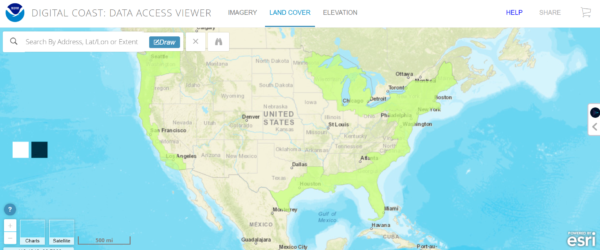
The NOAA Data Access Viewer is a free-to-use platform provided by the NOAA Office for Coastal Management, offering access to satellite imagery focused on the coastal regions of the United States, including Alaska, Hawaii, and U.S. territories. This resource is ideal for researchers, environmentalists, and GIS professionals seeking authoritative data for coastal areas.
The NOAA Data Access Viewer provides three primary types of data:
These free satellite maps are categorized by provider, dataset name, and year (ascending or descending). This system makes it easier to locate the specific free satellite imagery you need, particularly for coastal regions like California, Florida, and New York.
The platform includes several search options, such as:
These tools ensure that users can quickly find the most relevant datasets for their projects, whether for scientific research, coastal monitoring, or urban planning.
Downloading free satellite imagery is straightforward:
For users requiring bulk imagery, the platform supports bulk downloads, making it a practical solution for handling large datasets efficiently.
While the NOAA Data Access Viewer excels in providing free satellite imagery, it does not include built-in analysis tools. However, users can request customized datasets that are delivered via email. For standard analysis tasks, external GIS software is recommended.
The NOAA Data Access Viewer has replaced older NOAA systems, consolidating a variety of authoritative datasets into a single interface. Users can download:
This platform is no longer in beta mode but still faces occasional slow download speeds. Nevertheless, it is a reliable resource for anyone focusing on coastal regions.
The NOAA Data Access Viewer is a strong choice for obtaining free satellite imagery and related datasets, particularly for users interested in the coastal regions of the U.S. Its well-organized interface and variety of search options make it accessible for both beginners and experts.
The NOAA Data Access Viewer is perfect for environmental researchers, geospatial analysts, and coastal management professionals seeking reliable free satellite imagery and coastal datasets. If you’re working on projects involving land cover, elevation, or coastal studies, this platform is an invaluable resource.
Start exploring the NOAA Data Access Viewer today to unlock a wealth of free satellite imagery and elevate your research or project to the next level.
Visit – Explore Burj Khalifa from Space: High Resolution Satellite Images of Dubai’s Iconic Landmark

The Maxar Open Data Program provides free high-resolution online satellite imagery. Itis a powerful tool designed to provide high-resolution free satellite imagery for disaster response and emergency management. It’s especially valuable in times of natural calamities, offering satellite imagery free of charge for events like hurricanes, wildfires, floods, earthquakes, and other disasters. Maxar satellite platform is trusted by disaster relief organizations and humanitarian agencies to assist in managing disaster response and recovery efforts.
Maxar satellites capture some of the highest resolution imagery available, with details so sharp that you can often see individual buildings, roads, and even license plates. These high-definition satellite images are available for free under certain conditions, especially related to natural disasters. Maxar’s imagery is crucial for real-time disaster management, providing clarity and precision that helps in decision-making during emergency situations.
Maxar’s interface allows you to search for specific disaster events by name and date, offering imagery from the most recent events dating back to 2010. The platform makes it easy to find imagery related to specific disasters by displaying a list of available satellite images sorted by IDs and dates. This feature ensures that you can find the most relevant data for your needs, whether you’re working on a project related to disaster relief or conducting research on specific incidents.
Once you’ve located the imagery you need, Maxar allows you to download the satellite data directly to your computer. You can download TIFF files, which are high-quality image formats that preserve the detail of the original satellite photos. These downloads are available at no cost, providing access to crucial data in a format that’s ready for use.
Although Maxar provides free access to satellite imagery, the platform does not offer built-in analytical tools for processing the images. For users who want to analyze the imagery, third-party software such as GIS tools or remote sensing platforms will be required. This limitation means that while Maxar offers incredible high-resolution satellite imagery, it does not provide full data analysis capabilities directly within the platform.
Maxar offers two main ways to access free imagery:
Maxar’s Open Data Program is a standout for those needing satellite imagery related to disaster relief or those working with high-resolution satellite data. The combination of sharp details and free access during emergencies makes Maxar an invaluable resource. It’s also ideal for users who need imagery from significant natural events, offering high-definition snapshots that can be pivotal for decision-making and recovery planning.
Maxar’s Open Data Program is perfect for anyone involved in disaster relief and emergency management, including researchers, NGOs, and government agencies. It’s also great for those who want to explore high-resolution imagery for use in geospatial analysis, urban planning, or environmental monitoring.
Maxar’s high-resolution satellite imagery free offers an exceptional level of detail that’s perfect for supporting relief efforts during disasters and for experimenting with geospatial data at a level that few other platforms provide.
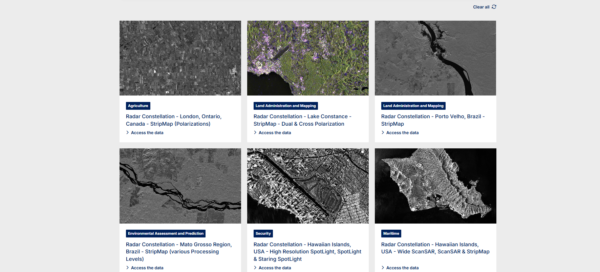
Geo-Airbus Defense is a commercial satellite imagery provider that delivers high-quality, accurate satellite data for various applications. While it’s more commonly known for its paid services, it also offers some free sample high-resolution satellite imagery for those who want to experiment or need limited access to high-resolution data.
Geo-Airbus Defense provides over 140 free sample images, making it a great resource for experimentation, especially for those exploring satellite imagery for the first time. The sample collection includes data from several of the company’s top satellite systems:
One of the standout features of Geo-Airbus’s offerings is radar imagery from TerraSAR-X, which has a resolution of up to 3 meters. This makes it perfect for applications like urban planning, infrastructure monitoring, and disaster response, where high detail is crucial, even in poor weather or night conditions.
Another unique offering is WorldDEM, a global digital elevation model (DEM) with 12-meter resolution. This global DEM is much finer and more accurate than other global DEMs, like ASTER and SRTM, and can be used for detailed topographic analysis and terrain modeling.
While the free satellite imagery provided by Geo-Airbus is of excellent quality, there are some limitations to note:
Geo-Airbus Defense offers some of the best commercial satellite imagery in the world, with exceptional resolution and specialized data products, including optical, radar, and DEM data. For users seeking high-quality satellite imagery free for experimentation or small-scale projects, Geo-Airbus provides an excellent entry point.
Geo-Airbus is ideal for professionals who need high-resolution satellite data for a variety of applications, including urban planning, environmental monitoring, and disaster management. If you’re looking for free satellite imagery for experimentation or small-scale tasks, Geo-Airbus offers an excellent starting point. However, for consistent, ongoing use of its data, a commercial subscription may be necessary.
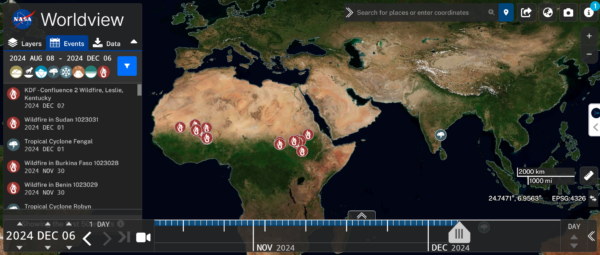
NASA’s Worldviewtool, part of the Earth Observing System Data and Information System (EOSDIS), provides users with free, interactive access to high-resolution satellite imagery. This platform offers near real-time data (updated every 3 hours) from multiple satellite sources, making it an excellent resource for studying natural disasters, environmental conditions, and much more.
NASA Worldview brings together data from various sources, including MODIS (Moderate Resolution Imaging Spectroradiometer), NOAA, and NASA’s LANCE (Land, Atmosphere Near real-time Capability for EOS). The satellite images are free to access and cover global events like wildfires, floods, and even air quality changes. These images are available in standard geospatial projections for most regions, including the Arctic and Antarctic.
Navigating NASA Worldview is simple. You can search by event or date using the timescale slider, allowing you to focus on specific global occurrences or access historical data. Whether you want to monitor wildfires, dust storms, or icebergs, the platform provides a direct way to access the latest satellite data from across the globe.
Users can browse imagery across a map, zoom in to specific areas, and track changes over time. The ability to filter by event makes it easy to find imagery related to natural disasters or other key incidents.
While NASA Worldview is a powerful tool for real-time monitoring, it does have some limitations in terms of downloading raw satellite data. Users can’t download data like the famous Blue Marble imagery, but it does allow for downloading snapshots.
Here’s how it works: after selecting your desired data layer, you can choose the date, and download the imagery in formats such as JPEG, PNG, GeoTIFF, or KMZ. You can also share a permanent link to your selected imagery, allowing others to access the same data.
One of the standout features of NASA Worldview is its ability to provide overlays. These map layers add context to the satellite imagery, enabling you to view phenomena like dust storms, wildfires, air quality, and more. You can also add base layers that show different aspects of the Earth’s surface, such as vegetation or ash plumes from volcanic eruptions. These visual tools help in analyzing and interpreting the satellite images in more meaningful ways.
NASA Worldview is designed to allow users to examine real-time data and apply it to research or public awareness campaigns.
NASA Worldview is more than just a satellite image provider—it offers access to a variety of scientific products across many disciplines. You can find information about natural hazards, including earthquakes and volcanic eruptions, as well as climate-related studies like ice sheet movements. The platform’s goal is to showcase these products for scientific and public use.
To download free satellite imagery, you can select a layer of interest, choose the date, and click the “Download Data” button. Although it’s not as comprehensive as some other platforms for raw data downloads, NASA Worldview is great for real-time observation and tracking specific events globally.
NASA Worldview is perfect for users looking to track specific events observable from space, such as wildfires, floods, or storms. It’s a great tool for those who want up-to-date Free satellite imagery for environmental studies, disaster management, or general research. The interactive interface makes it easy for users of all skill levels to engage with satellite data and understand major global phenomena.

The NOAA CLASS (Comprehensive Large Array-data Stewardship System) is a free electronic library that offers a vast collection of free satellite data focused on Earth’s environmental conditions. This includes imagery from a range of satellites, such as POES (Polar-orbiting Operational Environmental Satellite) and GOES (Geostationary Operational Environmental Satellite), as well as other key systems like Radarsat, Global Navigation Satellite System, and the Defense Meteorological Satellite Program.
NOAA CLASS provides access to satellite imagery of Earth that spans across diverse domains like weather, oceans, fisheries, and climate. Whether you’re interested in tracking storms, monitoring ocean temperatures, or observing environmental changes, the imagery and datasets available are invaluable. You can choose from a variety of resolutions, such as 1 meter or 4 meters, depending on your needs.
The satellite imagery available covers not only oceanic and atmospheric data but also broader environmental and climate information. CoastWatch, for instance, uses data from satellites like JASON to measure things like wind patterns, temperature, and ocean color. NOAA’s atmospheric imagery, particularly from GOES, is vital for tracking weather events, including hurricanes and tornadoes, while environmental and climate products focus on matters like ozone levels and aerosols.
To use NOAA CLASS and access satellite images, users must first register on the site. Once you have an account, you can search by data product, dataset name, or UUID. This allows for detailed searches based on specific environmental observations. You can easily track real-time data, such as updates on weather conditions and oceanic changes, through the site’s image of the day feature.
Once you find the data you need, downloading it is simple—just click the download button after selecting your desired output format (including map overlays, resolution, bands, and more). All this is available at no charge, provided you credit NOAA when using the imagery.
For those looking to extract specific information from the imagery, NOAA CLASS offers customizable data extraction options. Users can specify various settings, such as the number of channels, resolution, and bit depth of the image. You can also overlay different types of maps or visual aids for more comprehensive analysis.
Tracking the order status for your downloaded datasets is also made easy through the site’s navigation panel, with email notifications to keep you updated on the progress.
While NOAA CLASS may not be as intuitive or user-friendly as other platforms, it remains an excellent resource for accessing real-time satellite data—especially for weather-related observations. Its coverage of oceanic, atmospheric, and environmental conditions is vast, making it ideal for researchers, scientists, and anyone interested in monitoring these critical aspects of our planet.
The site provides access to GOES-R and NOAA-20 data, with GOES-R data being refreshed approximately every 15 minutes, offering near-real-time satellite imagery, though the resolution is typically lower (around 250 meters and above). While GOES-R satellites are in high geostationary orbits and offer lower-resolution imagery, they are indispensable for tracking major weather events and large-scale environmental changes.
NOAA CLASS is perfect for weather monitoring, environmental studies, and anyone interested in satellite imagery of Earth’s climate and atmospheric conditions. Despite its lower resolution, the free access to real-time data and long-term environmental observations makes it a powerful tool for understanding our planet’s dynamics.
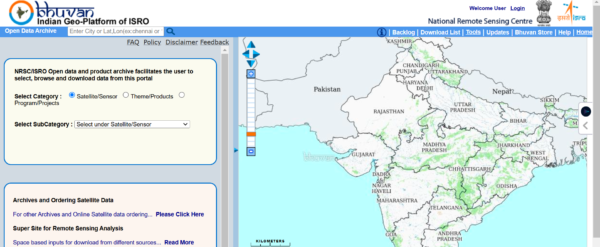
Bhuvan is a free remote sensing data provider operated jointly by the Indian Space Research Organization (ISRO) and the National Remote Sensing Centre (NRSC). This geo-platform offers a vast range of satellite imagery, mainly derived from Indian satellites, including IMS, Oceansat, Cartosat, and Resourcesat. It is an excellent resource for acquiring free satellite maps primarily covering the Indian subcontinent, with some global features available for use, such as NDVI (Normalized Difference Vegetation Index).
The free Satellite imagery available through Bhuvan is mostly focused on India but offers some datasets useful on a global scale. These datasets include a variety of satellite imagery such as:
One of the key offerings is NDVI, which provides global vegetation coverage and is widely used for monitoring plant health and environmental conditions. Additionally, CARTODEM, a 30-meter digital elevation model created from Cartosat-1 satellite stereo images, is available for global use.
Bhuvan provides several search options to help you find the most current free satellite maps. You can select your preferred satellite or sensor, or explore datasets based on themes such as:
The platform allows for a detailed selection of products, as well as programs and projects related to remote sensing.
While Bhuvan is a free portal, downloading data requires users to register on the platform. Once registered, you can access a variety of satellite images and maps. Detailed instructions are available to guide you through the process, ensuring you can easily download and work with the data you need.
Bhuvan offers several interactive tools for users to analyze and manipulate satellite imagery. These tools include:
This functionality makes it easier to visualize and interact with satellite data for analysis.
India has significantly advanced its capabilities in satellite remote sensing since the launch of the Indian Remote Sensing (IRS 1A) satellite in 1998. Since then, the Bhuvan platform has become an invaluable resource for researchers and scientists looking for high-quality remote sensing data. With a strong emphasis on Indian satellites like IMS, Cartosat, Oceansat, and ResourceSat, Bhuvan has played a pivotal role in the development of satellite technology for environmental and geographical studies.

ALOS World 3D (AW3D) is a free-to-use digital model of Earth’s surface, created by the Japan Aerospace Exploration Agency (JAXA). This model is designed to provide detailed elevation data at a global scale and is made available for non-commercial use. It is a remarkable tool for those needing precise digital elevation models (DEMs) for geographic and environmental studies.
The ALOS World 3D dataset is constructed from over 3 million satellite images captured by the PRISM tool onboard JAXA’s Advanced Land Observing Satellite (ALOS), which operated from 2006 to 2011. This satellite mission is crucial for generating accurate 3D surface models of Earth, offering 30-meter horizontal resolution, which is relatively high for global-scale elevation data.
The AW3D30 product provides high-precision elevation data for areas across the globe. It’s particularly useful for applications such as topographic mapping, natural disaster management, urban planning, and more. With this data, you can get a clearer understanding of Earth’s surface, including mountains, valleys, and built environments.
The ALOS World 3D interface allows users to zoom in and out or pan across the map using a mouse, offering a user-friendly experience. The program features several release versions, with the latest being version 4.0, which provides improved accuracy and functionality.
You can easily access the dataset through JAXA’s Global ALOS portal, where you can search by location to find the digital surface model data that fits your needs.
To download AW3D30, you must first register an account on the JAXA Global ALOS portal. Once your registration is approved, you can access and download the dataset through the portal. The Digital Surface Model (DSM) files are provided in GeoTIFF format, which is widely used for GIS applications. For users looking for different formats, the DSM can be converted into SRTM HGT files for easier use in various software.
While the ALOS World 3D platform provides great access to high-resolution elevation data, it does not offer built-in tools for analyzing the data directly on the platform. For those looking to process or analyze the data, you will need external GIS software like QGIS or ArcGIS, which can handle GeoTIFF and other geospatial formats.
The ALOS World 3D product is unique because it provides some of the most precise global-scale elevation data available for free. Its 30-meter resolution offers a balance between accuracy and usability for many types of geographic analysis, making it an excellent resource for researchers and organizations with non-commercial needs.
Moreover, the PRISM sensor used in the ALOS satellite allows for consistent and precise mapping across different terrains and regions, ensuring the data is reliable for various types of environmental, scientific, and urban studies.
This resource is ideal for researchers, urban planners, environmental scientists, and developers working on non-commercial projects. If you need global elevation data for mapping or analysis but don’t have access to commercial datasets, ALOS World 3D offers an excellent solution.
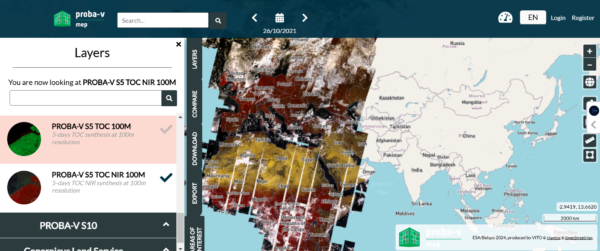
VITO Vision is a valuable platform that provides free satellite imagery, primarily focused on optical missions. The provider offers both free and subscription-based services, giving users access to satellite data collections with varying levels of detail. Subscribers benefit from more advanced features, such as enhanced search capabilities and the option to receive data as it becomes available in the future.
VITO Vision features several satellite image collections, each with its own resolution and focus. These collections include:
The resolution of the data ranges from 100 meters to 1 kilometer, offering a general view of the Earth’s surface. This makes VITO Vision particularly useful for large-scale environmental monitoring or other applications that don’t require extremely high-resolution imagery.
VITO Vision’s search interface allows users to define their region of interest, which can be specified by typing in a country or continent. Users can also select a date range for the satellite images they need. Once the search criteria are set, the platform displays results, which can be previewed in the form of thumbnails.
For free satellite imagery viewing, there’s no need to register, but to download images, users must first create an account and agree to the provider’s terms and conditions. The data can be downloaded in KML format, which is useful for integration with various mapping and GIS tools. Users can download images individually or in bulk. If you need larger datasets, VITO Vision provides an option to place an order and receive a download link via email. Additionally, you can quickly download data using an FTP client.
VITO Vision’s free satellite collections, like Proba-V (300 m), often include basic red band and NDVI projections (Normalized Difference Vegetation Index). These datasets are great for general analyses, such as monitoring vegetation patterns, but they may lack the detail required for specific applications.
For more specialized needs, the platform also offers the option for file stitching and band combinations, which can be customized upon request. This makes VITO Vision a suitable choice for users needing tailored satellite imagery products.
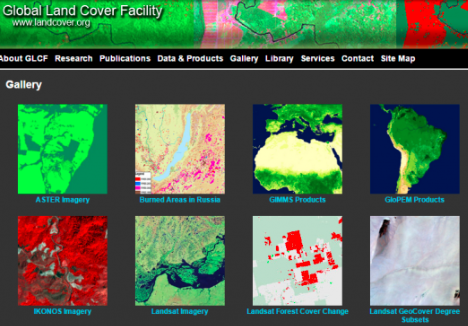
The Global Land Cover Facility (GLCF), hosted by the Department of Geographical Sciences at the University of Maryland, offers an expansive collection of FREE satellite imagery and is a critical resource for environmental research and land-cover monitoring. This provider is a key asset for anyone researching global environmental systems, and its data can be particularly useful for applications in resource management, disaster monitoring, and environmental science.
GLCF’s database focuses on the land cover of the Earth, offering insights into the changes occurring in forests, crops, grasslands, sands, and urban areas. The FREE satellite imagery provided by GLCF covers vast areas across the globe, capturing both local and global land changes. The data spans different types of land cover, from vegetation to urban construction, making it a powerful tool for monitoring global environmental systems and studying the impacts of climate change and human activity.
The facility uses data from renowned satellite programs such as Landsat, MODIS, and AVHRR, providing comprehensive and up-to-date images of the Earth’s surface. These datasets offer valuable insights into vegetation, agriculture, hydrology, and geological changes, highlighting the most pressing environmental issues of today, such as deforestation, urban expansion, and desertification.
GLCF allows users to perform spatial, temporal, and text-based searches. This flexibility enables users to find satellite imagery from specific regions, time periods, or land cover types. Whether you need a long-term historical perspective or a snapshot of recent changes, GLCF’s search options make it easy to find the imagery you need.
To streamline the search process, GLCF also offers a shopping cart feature, allowing users to gather datasets and download them at once. This makes it easier to access and manage large volumes of satellite data, particularly for those working on large-scale environmental projects.
To download the free satellite imagery from GLCF, users can use an FTP client for individual datasets. However, for larger-scale downloads, GLCF also provides access through the Earth Science Data Interface (ESDI), which enables the retrieval of detailed, high-resolution updated satellite maps. These downloads are available at no cost, making it an ideal platform for users who need vast amounts of satellite data for analysis, research, or project work.
One of the standout features of GLCF free satellite imagery is its ability to show land cover changes over time. By comparing the same areas at different time intervals, users can detect even the most subtle shifts in land cover. This is especially useful for tracking environmental changes like deforestation, urbanization, or the impact of natural disasters.
Through satellite imagery, GLCF allows for the observation of global land cover change, which is critical for understanding key environmental issues such as climate change and resource depletion. Remote sensing offers a detailed, wide-ranging perspective that is often impossible to obtain through ground-based observations alone.
GLCF is an essential resource for anyone working in environmental science, land-use planning, or resource management. The vast data archive it provides, which includes some of the most up-to-date satellite imagery available, gives users the tools to conduct in-depth studies of Earth’s land cover. It’s particularly valuable for those involved in studying the impacts of climate change or human development on ecosystems.
With data covering vegetation, agriculture, hydrology, urban areas, and more, GLCF supports a wide range of applications, from tracking environmental degradation to conducting scientific research on land use changes.
Free satellite Imagery of the Global Land Cover Facility is ideal for researchers, scientists, and environmental managers who need access to large-scale, detailed free satellite imagery. It is particularly valuable for those studying global land cover changes, climate change, urbanization, and natural resource management.
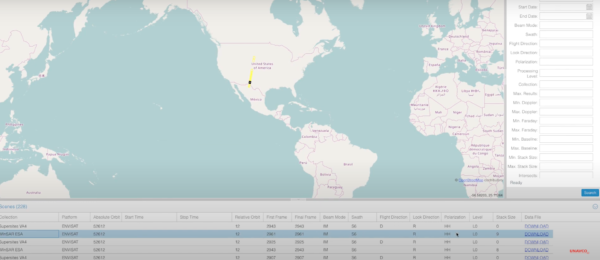
UNAVCO is a university consortium based in Colorado, U.S., and is a leading provider of free satellite imagery and geoscience data. This platform specializes in offering live satellite imagery and a wide variety of historical satellite maps in 2025 useful for scientific research and better decision-making. Through UNAVCO, users can access live, up-to-date satellite data, including GPS/GNSS, Synthetic Aperture Radar (SAR), Lidar, and more, all available for free.
UNAVCO provides access to several types of free satellite data, which are grouped into categories like GPS/GNSS, SAR, Lidar/SfM, seismic, and tropospheric data. The provider’s platform allows users to filter and access satellite data for both historical and live applications. You can find live satellite images in various formats such as BINEX, RINEX, and RTCM, along with other geospatial data tailored for research purposes.
Additionally, free up-to-date GPS satellite imagery & updated satellite maps 2025 is available daily or hourly, offering incredible flexibility for users who need current satellite data to make timely decisions. The platform even provides video tutorials and user guidelines for each data category, making it easier for users to understand how to navigate and make use of these valuable resources.
The UNAVCO platform is equipped with an intuitive search feature that allows you to easily access and narrow down your desired satellite data. You can filter the data by station name, network, and temporal availability to ensure that you get the most relevant information for your project. This powerful search feature makes it possible to explore historical satellite data or access the most recent live data, depending on your needs.
For those who are interested in accessing more complex datasets, such as SAR (Synthetic Aperture Radar), the platform provides access to the Seamless SAR Archive. Through this archive, users can select specific orbits, swaths, and satellite names to fine-tune their data selection. Access to SAR results is granted to affiliates of research institutions specializing in SAR technology.
UNAVCO provides a variety of options for downloading satellite images and geospatial data. To save your search results, simply add them to the cart and download the data using the UNAVCO downloader or compatible clients like Java, Web services, FTP, and GSAC. If you require access to satellite data, especially recent imagery, you can also request it via email directly from the provider. This makes live satellite data and historical imagery easily accessible to researchers, scientists, and other professionals in need of reliable geospatial data.
For users interested in SAR data, the Seamless SAR Archive offers the ability to select specific satellite orbits, swaths, and data sets that suit their needs. However, access to this data is typically restricted to affiliates of SAR research institutions.
In addition to providing access to free satellite imagery, UNAVCO offers specialized software to help process the acquired data. This includes tools for analyzing GPS/GNSS, SAR, and TLS data. By using these software tools, users can take full advantage of the satellite data they download and apply it to scientific research, environmental studies, and other applications that rely on accurate geospatial information.
UNAVCO stands out as an incredible resource for free satellite imagery & updated satellite maps, especially for those involved in scientific research and geodesy. With its focus on GPS/GNSS and SAR data, the platform is perfect for those studying plate tectonics, earthquakes, flooding, and other geophysical phenomena. The live satellite data and historical satellite images available through UNAVCO help researchers make informed decisions and advance our understanding of the Earth’s processes.
UNAVCO is ideal for researchers, scientists, and institutions focused on geodesy and geospatial data analysis. If you’re involved in studying natural disasters, environmental changes, or plate tectonics, the free satellite imagery provided by UNAVCO will be a crucial resource in your work. Additionally, if you are interested in live satellite data or historical satellite imagery, UNAVCO can provide you with the tools and data you need for better decision-making in your projects.

Zoom Earth offers one of the fastest and most up-to-date high-resolution free satellite imagery platforms available today. With near real-time updates and easy access to satellite maps free, this service is perfect for anyone needing a quick glance at the world’s current weather, storms, wildfires, or general conditions. Zoom Earth’s interface allows users to explore satellite imagery from 2000 or later, depending on the location, providing options to set the year, month, date, and time for historical data.
Zoom Earth displays almost real-time free satellite imagery, with updates occurring every 10 to 15 minutes. This frequent update cycle makes it ideal for tracking weather events, natural disasters like wildfires, and observing atmospheric phenomena. The imagery is pulled from multiple sources, including NOAA GOES, JMA Himawari-8, EUMETSAT Meteosat, and MODIS Aqua and Terra, ensuring the latest and most accurate data is displayed on the platform.
Finding updated satellite maps free is simple with Zoom Earth. Users can search for a specific location by entering its name in the search field. The search results will display high-resolution imagery, with data refreshed at regular intervals from global satellite networks. As you zoom in on the map, you will be able to access historical satellite images provided by Bing and Esri. These archived images are updated every few months, giving you a reliable look at long-term changes in the landscape.
While Zoom Earth doesn’t allow users to download satellite imagery free, it does provide a convenient sharing feature. You can easily share maps or satellite imagery on social media platforms such as Facebook, WhatsApp, Telegram, and Twitter, or via email. This makes it easy to collaborate or share interesting satellite views with others in real-time.
Although Zoom Earth does not offer extensive analysis tools, it provides a few basic features that may be useful for general exploration. For example, users can measure areas and distances on the map, zoom into specific locations, or track the movement of storms and wildfires. The platform also shows daily fire spots and storm tracks, which are helpful for monitoring current events.
Zoom Earth is an excellent tool for anyone needing quick access to up-to-date free satellite imagery & Updated satellite imagery. It’s particularly useful for those monitoring current weather conditions, tracking natural disasters like wildfires and storms, or anyone curious about the planet’s immediate state. While it doesn’t allow for in-depth analysis or image downloads, the service’s real-time satellite maps and easy-to-use interface make it a top choice for casual users and those in need of fast insights into global events.
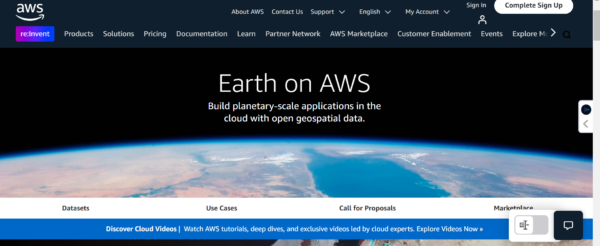
Earth on AWS is an extensive collection of free satellite imagery hosted on Amazon Web Services (AWS). It offers a vast registry of satellite maps and images from various providers, including Sentinel-2, Landsat-8, GOES-16, and CBERS. These datasets cover a wide range of applications, such as agriculture, disaster response, geospatial technology, and more. For anyone looking to access and utilize free satellite imagery, Earth on AWS is a powerful platform that simplifies the process of acquiring and processing geospatial data.
The datasets available on Earth on AWS are collected from a variety of satellite sources, including Sentinel-2, Landsat-8, NEXRAD, and GOES-16. These satellites provide data in different formats like multispectral mosaics, GeoTIFFs, and other geospatial products. Sentinel-2 datasets, for example, include RGB or RGB/NIR data, which are perfect for applications requiring detailed environmental monitoring. The CBERS satellite, hosted by AWS, provides valuable data collected by the China-Brazil Earth Resources Satellite, helping with agricultural and environmental studies.
For those in agriculture, disaster response, or geospatial technology, the Earth on AWS platform is an excellent resource for accessing satellite data tailored to their needs. The data can be applied directly to these fields, offering powerful tools for analysis and decision-making.
Using Earth on AWS, users can easily search through the free satellite imagery datasets by tags, and find over 80 datasets across different formats. For example, Sentinel-2 cloudless images can be selected by area, then viewed and downloaded directly onto your computer or mobile device. This streamlined process makes it easier for anyone to access free satellite imagery without navigating through complex interfaces.
The platform also offers GeoPackage or MapCache SQLite files, making it convenient for users to download satellite imagery in formats compatible with a wide range of GIS tools. Whether you’re working with raw satellite data or processed imagery, Earth on AWS provides the tools to download and store your datasets in a way that fits your project needs.
One of the standout features of Earth on AWS is its ability to handle large-scale satellite data processing using AWS Cloud Computing. The platform allows users to add their own layers to the maps, giving them the flexibility to customize and tailor data for their specific needs. This makes it an ideal solution for those looking to automate the processing of satellite imagery and utilize AWS’s powerful computing capabilities for analysis.
However, it is important to note that Earth on AWS requires a good understanding of how to interact with datasets via an API. The platform is not as user-friendly for those who are unfamiliar with the technical aspects of working with satellite data, as it is designed more for users looking to automate and process the data programmatically.
Earth on AWS is ideal for developers, researchers, and professionals in fields like geospatial technology or disaster response. If you have a specific need for free satellite imagery and are comfortable with technical tools like APIs and cloud computing, this platform is a perfect fit. It is also well-suited for those looking to automate satellite data processing using AWS’s cloud services.
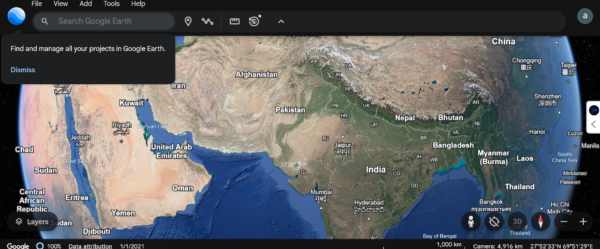
Google Earth is one of the most popular and easily accessible platforms for exploring free satellite imagery and historical satellite images & updated satellite maps in 2025. Originally known as Earth Viewer and later acquired by Google in 2004, Google Earth has become a tool beloved by millions for exploring Earth through satellite-derived maps. Available for Windows, Linux, macOS, Android, and iOS, the program offers both a free and Pro version to suit different needs.
Google Earth offers access to a vast range of satellite-derived maps that are continuously updated, with spatial resolution varying by region. Some of the most accurately captured areas include cities like Las Vegas, Nevada, and Cambridge, where satellite imagery has resolutions as fine as 15 cm. The platform integrates data from Landsat-8, aircraft, drones, kites, and even balloons, allowing you to view high-resolution satellite imagery of various global locations. Whether you’re interested in current views or historical satellite imagery, Google Earth offers both.
The search functionality in Google Earth makes it easy to zoom in on specific locations. Simply enter a geographic address or location, and you can instantly hover your mouse to zoom in and explore. A standout feature of this platform is that it provides users with both 2D and 3D representations of Earth, making it easy to visualize landscapes and urban areas. Additionally, many of the satellite maps available in Google Earth may date back decades, giving users access to historical satellite imagery to observe changes over time.
The free satellite imagery in Google Earth is available in KML or KMZ formats, which are commonly used for geographic data sharing. However, Google Earth Pro offers even more capabilities, including access to premium-quality satellite photos, extended datasets, and historical data. This version also allows for the importing and exporting of GIS maps, making it more suitable for advanced users and developers. While Google Earth itself doesn’t offer direct download options for the satellite imagery free, it allows users to print images exactly as they appear on the screen.
One unique feature of Google Earth is Google Timelapse, which lets users view changes to the Earth over a span of time. This free tool gives you access to historical satellite images and allows you to see how landscapes, urban developments, and ecosystems have evolved, offering a fascinating look at our ever-changing planet.
If you’re interested in analyzing satellite data, Google Earth may not have the tools for you, but Google Earth Engine steps in. This separate platform offers free access to satellite imagery for research, development, and academic purposes. Through Earth Engine, users can analyze satellite data in depth, which is invaluable for environmental studies, climate research, and more.
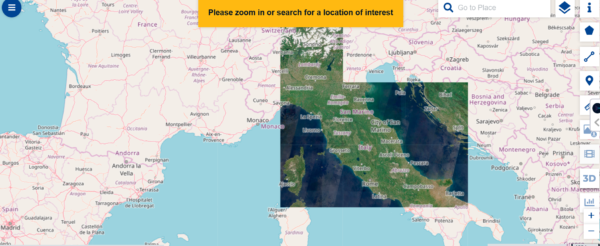
Sentinel Hub is a powerful platform for accessing free satellite imagery, offering two main services: EO Browser and Sentinel Playground. These services provide easy access to a wide range of high-quality satellite data, including Sentinel-2 and Landsat images. Whether you’re a researcher or a casual user, Sentinel Hub enables you to explore the Earth in a variety of ways, all for free.
The EO Browser allows users to explore satellite-based maps and access datasets from a number of satellite missions, including Sentinel-2, Landsat 5-8, MODIS, and Envisat Meris. EO Browser provides free access to medium- and low-resolution satellite images, along with a complete archive of Sentinel missions. You can search for specific areas, and the platform offers various filters to narrow down results, making it easier to find the imagery you need. However, some datasets, like Landsat images, require zooming in to at least 20 kilometers before they appear.
EO Browser also allows you to download free satellite imagery in formats such as JPEG, KMZ, and GeoTIFF, with the option to download full-resolution photos or individual bands. One of its key features is the ability to visualize and analyze the data by selecting different band combinations, creating time series, and more. While it’s user-friendly, it may not offer the same extensive analysis options as some other platforms.
For a more interactive experience, Sentinel Playground offers a satellite imagery mosaic of the globe, combining data from Sentinel-2, Landsat 8, MODIS, and DEM. This service allows you to explore and share small parts of the mosaic, which is particularly useful for those interested in high-quality satellite images from around the world. It’s more of a fun, casual tool, but it still offers an excellent way to get a broad view of Earth’s surface.
One of the most attractive features of Sentinel Hub is its access to Sentinel-2 data, which provides 10-meter resolution imagery, currently the best available for free satellite images. The Sentinel-2 satellites, with a revisit rate of just 5 days, provide detailed data in 12 spectral bands, covering everything from coastal to short-wave infrared (SWIR). This level of resolution makes Sentinel-2 imagery ideal for various applications, such as land monitoring, agriculture, and environmental studies.
In addition to optical imagery, Sentinel Hub also offers access to Sentinel-1 data, which includes SAR (Synthetic Aperture Radar) imagery. SAR can be particularly useful for monitoring and detecting changes over time, especially in environments where optical images are obscured by clouds or night conditions. SAR data is widely used for subsidence measurement, maritime monitoring, illegal fishing detection, and soil moisture mapping.
Sentinel Hub is ideal for researchers, scientists, and anyone with a prior understanding of geospatial data who needs free satellite imagery for monitoring and analysis. With Sentinel-2 and Sentinel-1 data, you can access a wide range of high-quality imagery that’s perfect for environmental research, urban planning, and much more.

NASA Earthdata Search is a powerful platform that provides online access to an extensive range of satellite images for free. This service, operated by NASA’s EOSDIS (Earth Observing System Data and Information System), grants users access to various datasets that cover a broad spectrum of Earth observations. Whether you’re interested in historical satellite images or real-time satellite imagery, this platform is an invaluable resource for researchers and scientists.
On NASA Earthdata Search, you’ll discover an impressive variety of free satellite imagery. The data is sourced from NASA’s Earth Observing System and includes imagery from satellite missions such as Aqua, Terra, Suomi-NPP, NOAA satellites, ENVISAT, METEOSAT, and many others. These satellites capture data on Earth’s atmosphere, oceans, land cover, vegetation, ice cover, and topography. You can explore free GIS maps that allow you to study the environment in incredible detail.
One of the unique features of NASA Earthdata Search is its extensive collection of both real-time and historical satellite images, offering insights into long-term changes in Earth’s environment. Whether you need recent satellite images for current studies or older imagery for historical analysis, this platform provides ample options.
The search interface in NASA Earthdata Search is comprehensive, but it can be a bit complex for newcomers. You will need to invest some time to get familiar with the platform’s search functionalities. The search tool allows you to filter satellite imagery by specific criteria, such as date, satellite platform, or location. However, the range of datasets and the way images are listed can be overwhelming, especially for users who are not familiar with satellite data collections.
For users who already have a clear idea of what they are looking for, NASA Earthdata Search offers an advanced search feature. However, for those who are less experienced, it might take some time to fully navigate the interface. The tutorials and descriptions provided can guide you through the process, though they may not be sufficient if you’re unsure of which dataset best matches your needs.
Once you’ve identified the satellite images for free that you want, downloading them can be straightforward, but there are a few caveats. Depending on the dataset, you may be required to approve certain applications before proceeding with the download. Some images or GIS maps may not be viewable in a preview before downloading, which could make it harder to ensure the dataset fits your needs. Despite these small challenges, the platform remains an invaluable source for free satellite imagery.
Unlike other platforms, NASA Earthdata Search does not offer built-in tools for analyzing the satellite imagery you download. To analyze the data, you will need to use external software, such as GIS or other remote sensing tools. This makes the platform better suited for experienced users who are familiar with geospatial analysis.
If you’re looking for a comprehensive and detailed satellite imagery free resource, NASA Earthdata Search is one of the best options available. Its ability to provide access to a wide range of historical and recent satellite images makes it ideal for long-term studies and research projects. The platform also offers specialized datasets from NASA Earth science data that may not be available on other sites.
NASA Earthdata Search is ideal for researchers, scientists, and experts looking for free satellite imagery for in-depth studies or long-term environmental research. If you’re an amateur or someone new to satellite image search, it might be helpful to start with more user-friendly platforms and return to Earthdata Search once you’re familiar with geospatial data and analysis.
EOSDA LandViewer is an excellent GIS platform that provides free satellite imagery and high-resolution satellite maps for users. It’s designed to be user-friendly, offering easy access to a wide range of free satellite images from both open-data sources and commercial providers. Whether you’re a beginner or an experienced user, EOSDA LandViewer allows you to search, preview, and download satellite imagery free of charge with a variety of analytical tools.
EOSDA LandViewer offers both medium and high-resolution satellite imagery online for free. You can access data from popular sources like Landsat 7, Landsat 8, Sentinel-1, Sentinel-2, MODIS, and more. These sources provide satellite images free for global coverage, and the platform also includes aerial data from the National Agriculture Imagery Program (NAIP). For users needing historical satellite imagery, EOSDA LandViewer provides access to older Landsat data, dating back to Landsat 4 and Landsat 5.
In addition to open-data sources, EOSDA LandViewer gives you the ability to preview high-resolution commercial satellite imagery before you make a purchase. Some of the free satellite imagery providers available include Kompsat, Gaofen, Ziyuan, and SuperView. These datasets offer exceptional spatial resolution, reaching up to 40 cm per pixel, providing an excellent tool for more detailed analysis.
Searching for free satellite maps on EOSDA LandViewer is straightforward. Once you’ve set your Area of Interest (AOI) using various input methods, such as file uploads or manual selection, you can easily filter the data by sensor type, acquisition dates, and other criteria like cloud cover percentage and solar elevation. The platform also allows you to subscribe to new satellite images, providing notifications when new satellite imagery free for your chosen area becomes available.
EOSDA LandViewer offers multiple ways to download satellite imagery free, ensuring you get exactly what you need. For example, if you want free Sentinel satellite imagery, you can download full images or cropped versions in various formats like JPEG, GeoTIFF, or KMZ. Additionally, users can select specific spectral bands using the Analytic download feature, or opt for a processed image, such as a band combination or a calculated index.
For those who don’t want to store data locally, EOSDA LandViewer provides the WMS feature, allowing you to stream satellite imagery directly to desktop GIS software.
What sets EOSDA LandViewer apart from other platforms is its instant visualization and analysis tools. After finding your desired satellite maps free, you can analyze them using over 20 default band combinations and indices like NDVI (Normalized Difference Vegetation Index), NBR (Normalized Burn Ratio), and SAVI (Soil-Adjusted Vegetation Index). You can also build custom indices with a raster calculator, conduct time series analysis, and utilize change detection tools. These features make EOSDA LandViewer an invaluable tool for industries such as agriculture, forestry, mining, construction, and environmental protection.
EOSDA LandViewer is an excellent tool for both GIS beginners and professionals in fields like agriculture, forestry, mining, and environmental protection. It’s particularly suited for users who need real-time satellite imagery and satellite data free, but don’t require specialized GIS software. With its easy-to-use interface and robust analytics, EOSDA LandViewer is ideal for anyone looking to obtain high-resolution satellite images and gain valuable insights into their areas of interest.
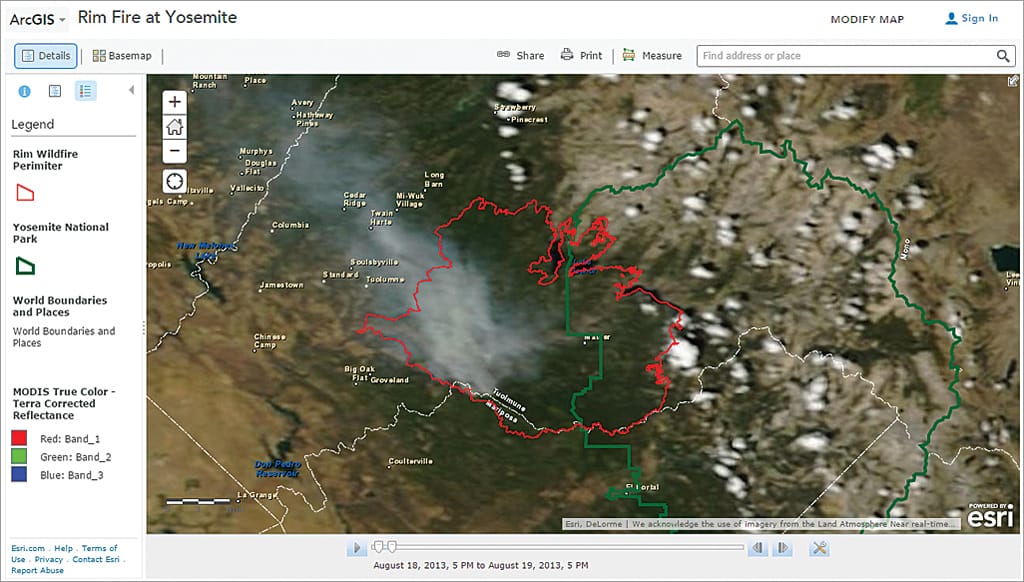
If you’re looking for free high-resolution satellite imagery that offers historical comparisons, the ESRI World Imagery Waybackis an excellent choice. It provides an interactive, browser-based archive that allows users to explore and compare historical satellite data from ESRI. Unlike Google Earth Pro, which offers extensive historical imagery, ESRI World Imagery Wayback focuses on selected snapshots over time. If you’re searching for specific images that may not be available on Google Earth, this tool is a great alternative.
One of its standout features is the ‘Swipe Mode,’ which enables users to compare imagery from different time periods effortlessly. This feature is highly useful for tracking environmental changes, urban development, or natural disasters. Another powerful feature is the ‘Animate Mode,’ which allows users to create time-lapse animations of a specific location over multiple years. The generated GIF animations can be downloaded and shared online, making it easier to showcase before-and-after changes in a visually appealing format.
The ESRI World Imagery Wayback is designed for users who need access to up-to-date and historical satellite imagery. The platform allows seamless access to archived satellite images, ensuring you can track developments in various locations. It provides easy navigation through multiple timestamps, so you can select the specific timeframe you need. The imagery is also available in high resolution, allowing for precise observation of geographic features and changes over time.
ESRI World Imagery Wayback enables users to download satellite images in different formats. You can capture screenshots, extract specific areas, and save high-resolution images for research or presentation purposes. The ability to download imagery ensures that users can analyze maps offline, making it a convenient tool for fieldwork and academic studies. If you’re looking for a free updated satellite map 2025, this platform provides valuable data that can be accessed without cost.
This platform is not just about viewing and downloading images; it also offers powerful analytical tools. You can overlay different time periods to detect changes, monitor land use patterns, and study environmental impacts. The 2025 satellite imagery available through ESRI can be integrated with Geographic Information System (GIS) software for further spatial analysis. With GIS capabilities, users can measure distances, assess terrain features, and generate in-depth reports based on satellite observations.
If you need the newest satellite maps 2025, ESRI World Imagery Wayback is a reliable choice because it continuously updates its satellite imagery collection. It provides an alternative to commercial services that require subscriptions, ensuring that anyone with internet access can explore high-quality satellite images. The ability to compare historical and recent imagery makes it a valuable resource for scientists, researchers, urban planners, and environmentalists.
Provides high-resolution satellite imagery with historical comparisons
Free access to updated and archived images
Features like ‘Swipe Mode’ and ‘Animate Mode’ enhance analysis
Allows users to create and download time-lapse animations
Compatible with GIS software for in-depth analysis
Offers a free updated satellite map 2025 with historical layers
The historical archive is not as extensive as Google Earth Pro
Some images may not have the highest resolution compared to paid services
Limited customization for downloading high-quality images in bulk
Researchers studying environmental changes and urban development
Students and educators looking for 2025 satellite maps for academic purposes
Disaster response teams analyzing before-and-after disaster imagery
Urban planners tracking infrastructure development over time
GIS professionals needing 2025 satellite imagery for mapping and spatial analysis
With ESRI World Imagery Wayback, users can access free updated satellite maps 2025, making it one of the best resources for obtaining high-resolution satellite imagery without any cost. Whether you’re a researcher, student, or GIS professional, this platform provides valuable satellite data to support various projects and analyses.
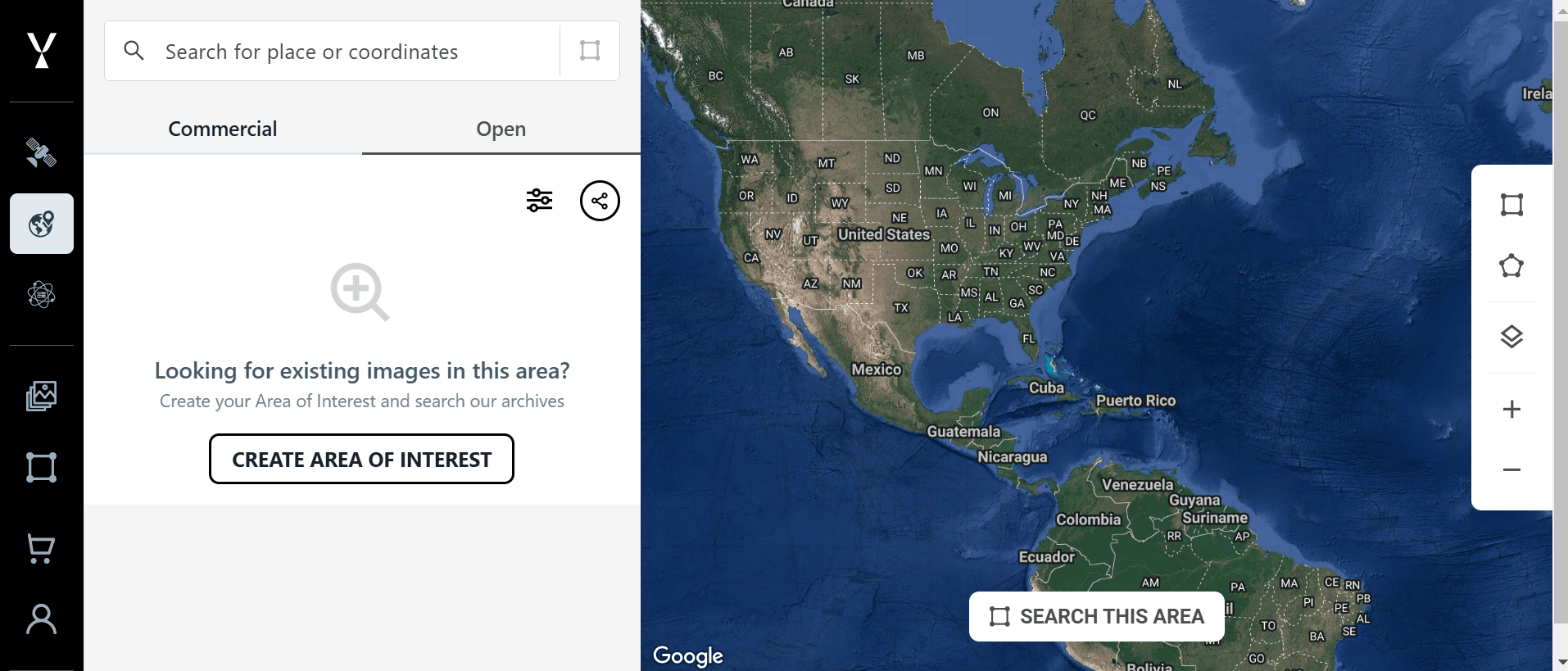
If you’re primarily a mobile user, SkyFi is an excellent choice for accessing free updated satellite map 2025 and other satellite imagery. Over the past year, SkyFi has grown into a popular platform for accessing both free and commercial satellite images. It offers a free mobile app and a web application that allow users to explore Sentinel datasets, access Umbra’s Open Data Catalog, and even purchase high-resolution commercial satellite imagery.
Downloading the SkyFi app is the first step to accessing 2025 high-resolution satellite imagery for free. After installation, users need to sign up for a free account, which ensures a smooth delivery process without unnecessary spam emails. This simple registration process enables quick access to the platform’s extensive satellite imagery collection.
Once logged into the SkyFi app, users can navigate to the map interface and select the ‘Explore’ tab at the bottom. From there, they can zoom into their desired location, select ‘Draw new area here,’ and adjust the selection by dragging the corners as needed. After defining the area of interest, selecting the ‘Open’ tab will display available newest satellite maps 2025, including free Sentinel-2 imagery options. Each satellite image comes with detailed metadata and preview options, allowing users to check image quality before downloading.
SkyFi makes it simple to search and access free updated satellite maps 2025 through its user-friendly mobile and desktop platforms. Users can quickly scan available imagery, preview scenes, and select the most relevant datasets. The platform’s search tools allow users to refine their results based on timeframes, cloud coverage, and resolution, ensuring they find the most suitable imagery for their needs.
Downloading 2025 satellite maps from SkyFi is straightforward. Once users find a suitable image, they can hit ‘ADD TO CART’ and proceed to checkout. SkyFi processes the order and delivers the selected 2025 satellite imagery via email and directly within the app. The delivery time is typically around 15-20 minutes, making it one of the fastest ways to obtain high-resolution, newest satellite maps 2025 for free.
While SkyFi is mainly designed for quick access to free updated satellite maps 2025, it also supports some basic analysis features. Users can inspect true-color images for general mapping purposes. However, for more advanced scientific or GIS applications, integrating SkyFi’s data with specialized software is recommended. The ability to quickly preview and download 2025 high-resolution satellite imagery makes it a convenient tool for mobile users and professionals who need satellite data on the go.
If you’re searching for free updated satellite map 2025, SkyFi offers an accessible and mobile-friendly platform. It provides a smooth user experience, rapid delivery times, and access to newest satellite maps 2025 from Sentinel-2 and other sources. Whether you’re a casual user, student, or researcher, SkyFi simplifies satellite imagery acquisition without requiring advanced technical knowledge.
Easy-to-use mobile and web applications for 2025 satellite maps
Free access to Sentinel-2 imagery and Open Data Catalog
Fast delivery times (typically 15-20 minutes)
Intuitive map interface with zoom and selection tools
High-quality 2025 satellite imagery available for free and commercial purchase
Limited advanced analysis tools for scientific applications
Some high-resolution images require purchase
Less extensive archive compared to Google Earth or ESRI
Mobile users looking for free updated satellite maps 2025
Casual users exploring 2025 satellite imagery for personal or educational purposes
Students and educators needing newest satellite maps 2025 for projects
Businesses and professionals who require quick satellite image access
Researchers tracking environmental and geographic changes
SkyFi is a powerful and accessible tool for obtaining 2025 satellite imagery without any hassle. Whether you’re interested in free updated satellite maps 2025 or want to explore historical and commercial options, this platform makes satellite data easily available in just a few clicks.

At XRTech Group, we specialize in providing advanced satellite imagery and planet monitoring services to help businesses, governments, and organizations make informed decisions and optimize their operations. With our AI-powered satellite imaging, high-resolution imagery, and real-time planet monitoring, we deliver valuable insights that support strategic planning and daily decision-making. Our satellite imagery and Latest Satellite Maps 2025 solutions are designed to empower industries like agriculture, energy, urban planning, and environmental management by providing precise, reliable, and actionable data.
Our Latest satellite imagery & Maps offers unparalleled precision and clarity, supporting industries like agriculture, urban planning, energy, and environmental monitoring. With high-resolution optical and radar imagery, we enable businesses to access critical information about land use, resource management, and environmental changes. This powerful tool allows for better decision-making and strategic planning, ensuring sustainable growth and efficient operations.
By leveraging advanced satellite imaging technologies, XRTech Group offers high-quality data for:
At XRTech Group, we offer cutting-edge real-time planet monitoring through our satellite-driven technologies. These solutions provide live data on the dynamic changes occurring on Earth, such as weather patterns, deforestation, and disaster management. Our satellite imagery and latest satellite maps empowers governments and organizations to respond quickly to natural disasters, track climate changes, and monitor environmental shifts.
Our advanced tools also provide essential insights for sectors such as agriculture, forestry, and climate science. For example:
Through the integration of AI with satellite imagery, XRTech Group enhances the efficiency of data analysis, enabling businesses to make predictions and optimize resources. Our AI-driven solutions help with crop yield estimation, environmental monitoring, and even predictive maintenance for infrastructure.
Key benefits of our AI-powered satellite analytics include:
XRTech Group offers comprehensive satellite data services that enable seamless integration of high-resolution imagery into your workflows. Whether you’re involved in urban planning, agriculture, environmental monitoring, or disaster management, our services provide real-time and historical data to inform better decision-making.
We also offer tailored solutions for specific industries:
XRTech Group’s satellite imagery is ideal for geospatial solutions, offering both optical imagery and radar imagery (SAR products) for precise mapping, monitoring, and analysis. Our high-resolution images support diverse applications, from smart city development to precision agriculture, ensuring the most reliable geospatial insights.
We also offer value-added products such as:
When choosing and making the most of free or commercial satellite imagery providers, there are several important tips to keep in mind to ensure you get the best results, whether for environmental monitoring, construction projects, or other GIS-related tasks.
Before diving into satellite imagery, it’s essential to understand what you need. Are you looking for high-resolution data for detailed analysis, or would medium-resolution images suffice for broader coverage? Commercial providers often offer higher-resolution images (down to 30 cm per pixel or better), but free services like Landsat or Sentinel might be sufficient for many purposes at a coarser scale.
Free satellite imagery providers, such as Landsat, Sentinel, and MODIS, offer accessible data, but they come with limitations in resolution and temporal coverage. Commercial providers like Maxar or Airbus offer high-resolution commercial satellite imagery with exceptional detail, but at a cost. Weighing these differences based on your project’s budget and specific requirements is crucial.
Satellite imagery providers vary greatly in terms of temporal coverage (how frequently they update their imagery). Some providers offer frequent updates, such as Sentinel-2 which revisits areas every five days. If your project requires near real-time data, look for providers offering high revisit rates.
Different platforms offer various tools for image processing, such as time series analysis, change detection, and custom index builders (like NDVI for vegetation monitoring). Some providers also allow cloud filtering to enhance image quality, which is especially useful when dealing with cloud cover in certain regions.
Many satellite imagery platforms offer download options compatible with GIS software like ArcGIS or QGIS. Formats such as GeoTIFF, KMZ, or JPEG are standard, and some platforms provide WMS (Web Map Service) integration, which makes it easier to stream imagery directly into your software without downloading large files.
Most commercial satellite imagery providers allow you to preview or sample small areas of high-resolution data for free. Take advantage of these free previews to evaluate the quality of the imagery before committing to a purchase.
Many free satellite imagery providers, like NASA’s Earth Observing System Data and Information System (EOSDIS), offer advanced analytics such as change detection, vegetation index mapping, and thermal imaging. Learning how to use these tools effectively can greatly enhance the value of the data.
For areas of frequent interest, set up notifications to alert you when new imagery becomes available. This can be especially valuable if you’re monitoring ongoing events or projects, like agricultural crop health or environmental changes.
By considering these factors and matching the right provider to your needs, you can maximize the value of the satellite imagery—whether free or commercial—for your specific project.
Satellite imagery has revolutionized the way we explore and analyze our planet, providing vast amounts of data for various uses like environmental monitoring, agriculture, and urban planning. Instead of spending time searching for base maps, there are numerous free satellite imagery data sources you can access globally.
Satellite imagery is used for various applications like weather forecasting, agriculture, disaster management, urban planning, defense, and environmental monitoring. It helps in analyzing geographical changes and improving decision-making processes.
The main types include optical imagery, which captures light in the visible spectrum; radar imagery, which uses microwaves to detect surface features; and hyperspectral imagery, which collects data across numerous wavelengths for detailed analysis.
The accuracy depends on the satellite and resolution. High-resolution satellites can capture details as small as 30 cm, while lower-resolution images are used for broader analyses like land cover or vegetation monitoring.
Raw data is unprocessed and contains information as captured by the satellite sensors. Processed data is enhanced and interpreted, making it easier for users to analyze specific features or patterns.
Yes, platforms like XRTech Group, USGS Earth Explorer, NOAA Data Access Viewer, and ESA’s Copernicus Hub provide free access to satellite imagery for educational, research, and non-commercial use.
Satellites use infrared sensors or radar imaging to capture data at night. These technologies detect heat emissions or use microwaves to map the Earth’s surface regardless of light availability.
Cloud cover, atmospheric conditions, and resolution significantly influence image quality. High-resolution satellites and cloud-free conditions produce the best imagery.
DEMs are 3D representations of terrain elevation, created using satellite data. They are widely used in topographic analysis, flood modeling, and infrastructure planning.
Update frequency depends on the satellite’s orbit and purpose. Some satellites revisit areas every few days, while others provide near-real-time updates for critical applications like weather tracking.
Popular software includes ArcGIS, QGIS, and ERDAS Imagine. These tools help process, analyze, and visualize satellite data for various applications. Many also support integration with AI and machine learning for advanced analytics.
Costs vary widely depending on the resolution, frequency, and type of data requested. Public platforms like Google Earth offer free access, while premium data from private providers can be expensive.
Satellite data tracks changes in glaciers, sea levels, and deforestation, providing critical insights into environmental shifts and aiding in predictive modeling for climate actions.
While not exactly real-time, satellites can provide updates with minimal delays, especially with constellations designed for frequent revisits, making them valuable for disaster response and event monitoring.
Innovations include AI-powered imagery analysis, 3D data generation, and the ability to monitor changes in near-real time. These advancements enhance applications in mapping, security, and environmental monitoring.
Historical imagery helps analyze changes over time, such as urban expansion, climate impacts, or deforestation. Tools like Google Earth now offer decades of archived images for analysis.
Common users include agriculture, urban planning, environmental monitoring, defense, and logistics, leveraging data for tasks like crop health assessment, disaster management, and precision mapping.
Advanced satellites can revisit the same area multiple times a day, with some capable of imaging every 20 to 30 minutes, depending on their orbit and tasking.
High-resolution satellites, provide images with a 15cm to 30 cm resolution, enabling detailed analysis of features like road markings and solar panels on rooftops.
Free Aerial View of Airports | Satellite Images of Denver and Las Vegas Airports
Photos of the New 7 Wonders of the World | Satellite Imaging
Explore Burj Khalifa from Space: High Resolution Satellite Images of Dubai’s Iconic Landmark
Free Satellite Imagery of Mount Everest: High-Resolution Aerial Views
Satellite Imagery of Antarctica: High-Resolution Satellite Photos of Antarctica
What is Digital Elevation Model
What is Satellite Imagery? Types, Uses & How to Get – Full Guide
Can I See a Live Satellite Images of My House in Real Time? | Satellite View of My House
Satellite Types in Earth’s Orbits: Functions, Uses & High-Resolution Satellite Images

Satellite imagery has become one of the most powerful tools for understanding our world, capturing every detail of Earth from
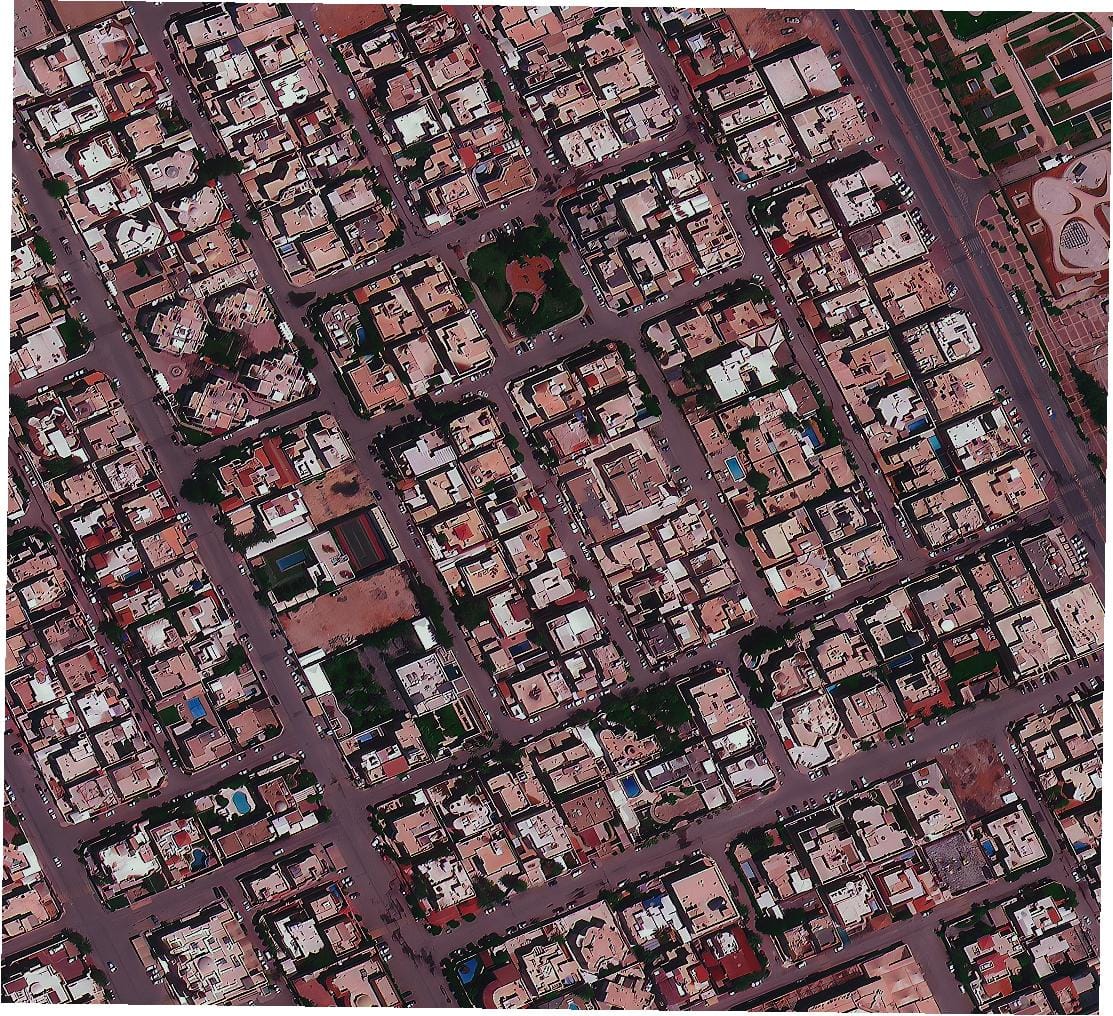
Understanding the Growing Market for Maxar Competitors Satellite imagery and geospatial intelligence have become essential for governments, industries, and research

For a limited time, get high-resolution 30cm new tasking satellite images Free.
✅ Crystal-clear 30cm resolution
✅ Fast & accurate satellite data collection
✅ Exclusive offer for registered users only